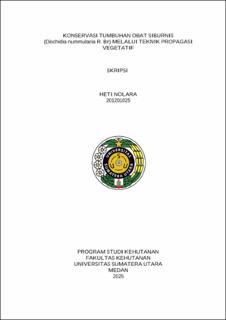Konservasi Tumbuhan Obat Siburnis (Dischidia nummularia R. Br) Melalui Teknik Propagasi Vegetatif
Conservation of the Medicinal Plant Siburnis (Dischidia nummularia R. Br) Through Vegetative Propagation Techniques

Date
2025Author
Nolara, Heti
Advisor(s)
Zahrah, Marifatin
Susilowati, Arida
Metadata
Show full item recordAbstract
Siburnis is one of the epiphytic medicinal plants that usually grows attached to and creeping on trees. The Batu Katak village community uses Siburnis as a mixture of massage oil (karo oil) and is used in yellow bergeh (cold parem) potions. However, the community still has difficulty obtaining Siburnis because they only rely on natural regeneration, while its utilization tends to be faster than its ability to grow back. The community has never cultivated Siburnis plants because of the lack of community knowledge about how to cultivate this plant. To reduce the risk of limited materials for making traditional medicine and sustainable production of karo potions, it is necessary to carry out sustainable propagation techniques for Siburnis medicinal plants. One alternative propagation technique that can be used is the stem cutting technique. The aim of this research was to obtain information on the percentage of survival cuttings of the siburnis type through stem cuttings and to obtain the best media for Siburnis propagation. This study used a non-factorial completely randomized design (CRD), consisting of 2 treatments and 7 replications. Each replication consisted of 1 plant, so there were 14 test. The results of the study showed that the success of the propagation of the siburnis species through stem cuttings showed varying results depending on the treatment applied. Of the two treatments used, the P1 treatment proved to be the most successful, where all cuttings successfully grew for 3 months from seven repetitions carried out. Likewise, the P2 treatment also showed positive results with two repetitions successfully growing and five repetitions unsuccessful. The P1 treatment with a 2:1 cocopeat formulation with carbonize rice husks was the best medium and had a significant effect on this study.
Collections
- Undergraduate Theses [2162]
